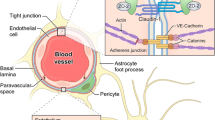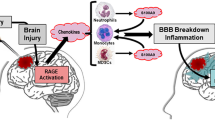Abstract
Intracerebral microdialysis enables continuous measurement of changes in brain biochemistry. In this study intracerebral microdialysis was used to assess changes in cytokine levels after tumor resection and in response to treatment with temsirolimus. Brain tumor patients undergoing craniotomy participated in this non-therapeutic study. A 100 kDa molecular weight cut-off microdialysis catheter was placed in peritumoral tissue at the time of resection. Cohort 1 underwent craniotomy only. Cohort 2 received a 200 mg dose of intravenous temsirolimus 48 h after surgery. Dialysate samples were collected continuously for 96 h and analyzed for the presence of 30 cytokines. Serial blood samples were collected to measure systemic cytokine levels. Dialysate samples were obtained from six patients in cohort 1 and 4 in cohort 2. Seventeen cytokines could be recovered in dialysate samples from at least 8 of 10 patients. Concentrations of interleukins and chemokines were markedly elevated in peritumoral tissue, and most declined over time, with IL-8, IP-10, MCP-1, MIP1β, IL-6, IL-12p40/p70, MIP1α, IFN-α, G-CSF, IL-2R, and vascular endothelial growth factor significantly (p < 0.05) decreasing over 96 h following surgery. No qualitative changes in intracerebral or serum cytokine concentrations were detected after temsirolimus administration. This is the first intracerebral microdialysis study to evaluate the time course of changes in macromolecule levels in the peritumoral microenvironment after a debulking craniotomy. Initial elevations of peritumoral interleukins and chemokines most likely reflected an inflammatory response to both tumor and surgical trauma. These findings have implications for development of cellular therapies that are administered intracranially at the time of surgery.

Similar content being viewed by others
References
Zhao D, Najbauer J, Annala AJ, Garcia E, Metz MZ, Gutova M et al (2012) Human neural stem cell tropism to metastatic breast cancer. Stem Cells 2:314–325
Schmidt NO, Wojciech P, Yang W, Ziu M, Teng Y, Kim SU et al (2005) Brain tumor tropism of transplanted human neural stem cells is induced by vascular endothelial growth factor. Neoplasia 6:623–629
Zhao D, Najbauer J, Garcia E, Metz MZ, Gutova M, Glackin CA et al (2008) Neural stem cell tropism to glioma: critical role of tumor hypoxia. Mol Cancer Res 12:1819–1829
Blakeley JO, Portnow J (2010) Microdialysis for assessing intratumoral drug disposition in brain cancers: a tool for rational drug development. Expert Opin Drug Metab Toxicol 6:1477–1491
de Lange EC, Danhof M, de Boer AG, Breimer DD (1997) Methodological considerations of intracerebral microdialysis in pharmacokinetic studies on drug transport across the blood-brain barrier. Brain Res Rev 25:27–49
Zhou Q, Gallo JM (2005) In vivo microdialysis for PK and PD studies of anti-cancer drugs. AAPS J 7:E659–E667
Chan TV, Ng SC, Lam JM, Poon WS, Gin T (2005) Monitoring of autoregulation using intracerebral microdialysis in patients with severe head injury. Acta Neurochir Suppl 95:113–116
Kett-White R, Hutchinson PJ, Al-Rawi PG, Gupta AK, Pickard JD, Kirkpatrick PJ (2003) Adverse cerebral events detected after subarachnoid hemorrhage using brain oxygen and microdialysis probes. Neurosurgery 50:1213–1221
Miller CM, Vespa PM, McArthur DL, Hirt D, Etchepare M (2007) Frameless stereotactic aspiration and thrombolysis of deep intracerebral hemorrhage is associated with reduced levels of extracellular cerebral glutamate and unchanged lactate pyruvate ratios. Neurocrit Care 6:22–29
Salci K, Nilsson P, Howells T, Ronne-Engstrom E, Piper I, Contant CF Jr et al (2006) Intracerebral microdialysis and intracranial compliance monitoring of patients with traumatic brain injury. J Clin Monit Comput 20:25–31
Staub F, Graf R, Gabel P, Kochling M, Klug N, Heiss WD (2000) Multiple interstitial substances measured by microdialysis in patients with subarachnoid hemorrhage. Neurosurgery 47:1106–1115
Vespa P, Boonyaputthikul R, McArthur DL, Miller C, Etchepare M, Bergsneider M et al (2006) Intensive insulin therapy reduces microdialysis glucose values without altering glucose utilization or improving the lactate/pyruvate ratio after traumatic brain injury. Crit Care Med 34:850–856
Wang E, Ho CL, Lee KK, Ng I, Ang BT (2008) Changes in brain biochemistry and oxygenation in the zone surrounding primary intracerebral hemorrhage. Acta Neurochir Suppl 102:293–297
Portnow J, Badie B, Chen M, Liu A, Blanchard S, Synold TW (2009) The neuropharmacokinetics of temozolomide in patients with resectable brain tumors: potential implications for the current approach to chemoradiation. Clin Cancer Res 15:7092–7098
Portnow J, Badie B, Markel S, Liu A, D’Apuzzo M, Frankel P, Jandial R, Synold TW (2013) A Neuropharmacokinetic Assessment of Bafetinib, a Second Generation Dual BCR-Abl/Lyn Tyrosine Kinase Inhibitor, in Patients with Recurrent High-Grade Gliomas. Eur J Cancer 49(7):1634–1640
Portnow J, Badie B, Synold T, Lacey S, D’Apuzzo M, Frankel P, Chen M, Aboody K. (2012) Neural stem cell (NSC)-mediated conversion of 5-fluorocytosine (5-FC) to 5-fluorouracil (5-FU) in recurrent high-grade glioma patients: a proof of concept. The Meeting for Society for Neuro-Oncology; NO-77
Bergenheim AT, Capala J, Roslin M, Henriksson R (2005) Distribution of BPA and metabolic assessment in glioblastoma patients during BNCT treatment: a microdialysis study. J Neurooncol 71:287–293
Blakeley JO, Olson J, Grossman SA, He X, J Weingart, Supko JG (2009) Effect of blood brain barrier permeability in recurrent high grade gliomas on the intratumoral pharmacokinetics of methotrexate: a microdialysis study. J Neurooncol 91:51–58
Lee SA, Kim SM, Son YH, Lee CW, Chung SW, Eo SK et al (2011) Peptidoglycan enhances secretion of monocyte chemoattractants via multiple signaling pathways. Biochem Biophys Res Commun 408:132–138
Sola-Villa D, Camacho M, Sola R, Soler M, Diaz JM, Vila L (2006) IL-1beta induces VEGF, independently of PGE2 induction, mainly through the PI3-k/mTOR pathway in renal mesangial cells. Kidney Int 70:1935–1941
Chang SM, Wen P, Cloughesy T et al (2005) Phase II study of CCI-779 in patients with recurrent glioblastoma multiforme. Invest New Drugs 23:357–361
Galanis E, Buckner JC, Maurer MJ et al (2005) Phase II trial of temsirolimus (CCI-779) in recurrent glioblastoma multiforme: a North Central Cancer Treatment Group study. J Clin Oncol 23:5294–5304
Kuhn JG, Chang SM, Wen PY, Cloughesy TF, Greenberg H, Schiff D et al (2007) Pharmacokinetic and tumor distribution characteristics of temsirolimus in patients with recurrent malignant glioma. Clin Cancer Res 13:7401–7406
Brown CE, Vishwanath RP, Aguilar B, Starr R, Najbauer J, Aboody KS et al (2007) Tumor-derived chemokine MCP-1/CCL2 is sufficient for mediating tumor tropism of adoptively transferred T cells. J Immunol 179:3332–3341
Dwyer RM, Potter-Beirne SM, Harrington KA, Lowery AJ, Hennessy E, Murphy JM et al (2007) Monocyte chemotactic protein-1 secreted by primary breast tumors stimulates migration of mesenchymal stem cells. Clin Cancer Res 13:5020–5027
Magge SN, Malik SZ, Royo NC, Chen HI, Yu L, Snyder EY et al (2009) Role of monocyte chemoattractant protein-1 (MCP-1/CCL2) in migration of neural progenitor cells toward glial tumors. J Neurosci Res 87:1547–1555
Strieter RM, Belperio JA, Phillips RJ, Keane MP (2004) CXC chemokines in angiogenesis of cancer. Semin Cancer Biol 14:195–200
Bourke E, Moynagh PN (1999) Antiinflammatory effects of glucocorticoids in brain cells, independent of NF-kB. J Immunol 163:2113–2119
Bessler H, Mendel C, Straussberg R, Gurary N, Aloni D, Sirota L (1999) Effects of dexamethasone on IL-1beta, IL-6, and TNF-alpha production by mononuclear cells in newborns and adults. Biol Neonate 75:225–2233
Mustafa MM, Ramilo O, Saez-Llorens X, Olsen KD, Magness RR, McCracken GH Jr (1990) Cerebrospinal Fluid prostaglandins, interleukin 1 beta, and tumor necrosis factor in bacterial meningitis. Clinical and laboratory correlations in placebo-treated and dexamethasone-treated patients. Am J Dis Child 144:883–887
Helmy A, De Simoni MG, Guilfoyle MR, Carpenter KL, Hutchinson PJ (2011) Cytokines and innate inflammation in the pathogenesis of human traumatic brain injury. Prog Neurobiol 95:352–372
Brat DJ, Bellail AC, Van Meir EG (2005) The role of interleukin-8 and its receptors in gliomagenesis and tumoral angiogenesis. Neuro Oncol 7:122–133
Li A, Dubey S, Varney ML, Dave BJ, Singh RK (2003) IL-8 directly enhanced endothelial cell survival, proliferation, and matrix metalloproteinases production and regulated angiogenesis. J Immunol 170:3369–3376
Mukaida N, Harada A, Matsushima K (1998) Interleukin-8 (IL-8) and monocyte chemotactic and activating factor (MCAF/MCP-1), chemokines essentially involved in inflammatory and immune reactions. Cytokine Growth Factor Rev 9:9–23
Helmy A, Carpenter KLH, Menon DK, Pickard JD, Hutchinson PJ (2011) The cytokine response to human traumatic brain injury: temporal profiles and evidence for cerebral parenchymal production. J Cereb Blood Flow Metab 31:658–670
Hillman J, Aneman O, Anderson C, Sjogren F, Saberg C, Mellergard P (2005) A microdialysis technique for routine measurement of macromolecules in the injured human brain. Neurosurgery 56:1264–1268
Hillman J, Aneman O, Persson M, Andersson C, Dabrosin C, Mellergard P (2007) Variations in the response of interleukins in neurosurgical intensive patients monitored using intracerebral microdialysis. J Neurosurg 106:820–825
Hutchinson PJ, O’Connell MT, Rothwell NJ, Hopkins SJ, Nortje J, Carpenter KL et al (2007) Inflammation in human brain injury: intracerebral concentrations of IL-1α, IL-1β, and their endogenous inhibitor IL-ra. J Neurotrauma 24:1545–1557
Marcus HJ, Carpenter KLH, Price SJ, Hutchinson PJ (2010) In vivo assessment of high- grade glioma biochemistry using microdialysis: a study of energy-related molecules, growth factors and cytokines. J Neurooncol 97:11–23
Mellergard P, Aneman O, Sjogren F, Pettersson P, Hillman J (2008) Changes in extracellular concentrations of some cytokines, chemokines, and neurotrophic factors after insertion of intracerebral microdialysis catheters in neurosurgical patients. Neurosurgery 62:151–158
Mellergard P, Aneman O, Sjogren F, Saberg C, Hillman J (2011) Differences in cerebral extracellular response of interleukin-1β, interleukin-6, and interleukin-10 after subarachnoid hemorrhage or severe head trauma in humans. Neurosurgery 68:12–19
Mellergard P, Sjogren F, Hillman J (2010) Release of VEGF and FGF in the extracellular space following severe subarachnoid haemorrhage or traumatic head injury in humans. Br J Neurosurg 24:261–267
Perez-Barcena J, Ibanez J, Brell M, Crespi C, Frontera G, Llompart-Pou JA et al (2011) Lack of correlation among intracerebral cytokines, intracranial pressure, and brain tissue oxygenation in patients with traumatic brain injury and diffuse lesions. Crit Care Med 39:533–540
Sarrafzadeh A, Schlenk F, Gericke C, Vajkoczy P (2010) Relevance of cerebral interleukin-6 after aneurysmal subarachnoid hemorrhage. Neurocrit Care 13:339–346
Winter CD, Iannotti F, Pringle AK, Trikkas C, Clough GF, Church MK (2002) A microdialysis method for the recovery of IL-1β, IL-6 and nerve growth factor from human brain in vivo. J Neurosci Methods 119:45–50
Winter CD, Pringle AK, Clough GF, Church MK (2004) Raised parenchymal interleukin-6 levels correlate with improved outcome after traumatic brain injury. Brain 127:315–320
Ilyin SE, Gonzalez-Gomez I, Romanovicht A, Gayle D, Gilles FH, Plata-Salaman CR (2000) Autoregulation of the interleukin-1 system and cytokine–cytokine interactions in primary human astrocytoma cells. Brain Res Bull 51:29–34
Pietsch T, Valter MM, Wolf HK, von Deimling A, Huang HJ, Cavenee WK et al (1997) Expression and distribution of vascular endothelial growth factor protein in human brain tumors. Acta Neuropathol (Berl) 93:109–117
Piperi C, Zisakis A, Lea RW, Kalofoutis A (2005) Role of cytokines in the regulation of glioma tumour growth and angiogenesis. Am J Immunol 1:106–113
Tsai JC, Goldman CK, Gillespie GY (1995) Vascular endothelial growth factor in human glioma cell lines: induced secretion by EGF, PDGF-BB, and bFGF. J Neurosurg 82:864–873
Van Meir E, Sawamura Y, Diserens AC, Hamou MF, De Tribolet N (1990) Human glioblastoma cells release interleukin 6 in vitro and in vivo. Cancer Res 50:6683–6688
Helmy A, Carpenter KLH, Skepper JN, Kirkpatrick PJ, Pickard JD, Hutchinson PJ (2009) Microdialysis of cytokines: methodological considerations, scanning electron microscopy, and determination of relative recovery. J Neurotrauma 26:549–561
Acknowledgments
We thank Brenda Williams, RN, for her management of the microdialysis catheters and Keely Walker, PhD, for her valuable editing of the manuscript. Sources of funding: National Institutes of Health (K12CA01727 to J.P.); Phase One Foundation; Pfizer, Inc.
Conflict of interest
The authors have no conflicts of interest to declare.
Author information
Authors and Affiliations
Corresponding author
Electronic supplementary material
Below is the link to the electronic supplementary material.
Rights and permissions
About this article
Cite this article
Portnow, J., Badie, B., Liu, X. et al. A pilot microdialysis study in brain tumor patients to assess changes in intracerebral cytokine levels after craniotomy and in response to treatment with a targeted anti-cancer agent. J Neurooncol 118, 169–177 (2014). https://doi.org/10.1007/s11060-014-1415-4
Received:
Accepted:
Published:
Issue Date:
DOI: https://doi.org/10.1007/s11060-014-1415-4




